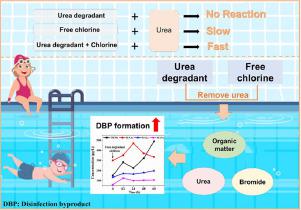Water Research ( IF 12.8 ) Pub Date : 2022-08-15 , DOI: 10.1016/j.watres.2022.118987 Di Zhang 1 , Li Chen 1 , Shengkun Dong 2 , Jiayi Luo 3 , Zuxin Xu 1 , Wenhai Chu 1

|
In China, urea degradants are often used in combination with chlorine in swimming pool water to remove urea. Here we report the first study about the impacts of urea degradants on urea degradation, disinfection byproduct (DBP) formation and estimated DBP-associated cytotoxicity and genotoxicity. Firstly, four groups of typical DBPs from six real indoor swimming pools were analyzed. The concentration of DBPs in swimming pool waters was about 1-2 orders of magnitude higher than that source tap water. Notably, a rapid increase in DBPs was observed after urea degradant treatment. Simulated processes of urea removal using three commonly used urea degradants were therefore conducted in laboratory. Neither urea degradant nor chlorine alone removed urea effectively within 48 h. When applied in combination, urea degradant with sufficient chlorine rapidly removed urea by 100% within 3 h, and anti-chlorourea oligomer in urea degradants was the main contributor. Meanwhile, a remarkable increase in DBPs, especially brominated DBPs, was observed due to bromide introduction by urea degradants. For this reason, bromine incorporation factor (BIF) of DBPs dramatically increased. For instance, the BIF of dihaloacetic acids increased by 2665%-4025% after applying three urea degradants. As the highly toxic brominated DBPs were generated, attention should be paid into the potential DBP-related health risks from the use of urea degradants together with chlorine.



























 京公网安备 11010802027423号
京公网安备 11010802027423号